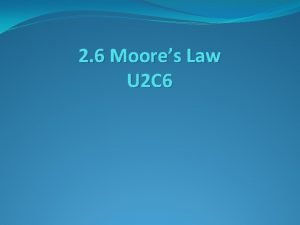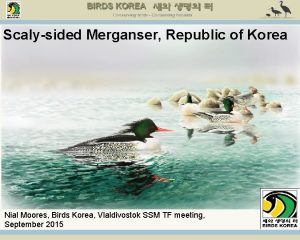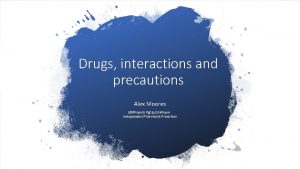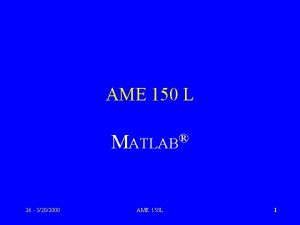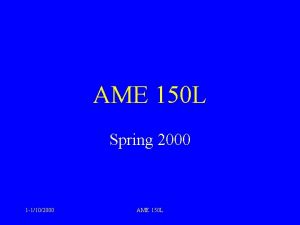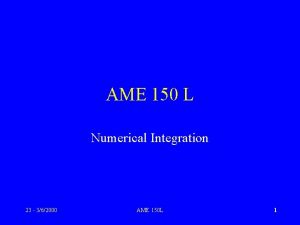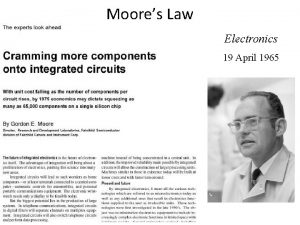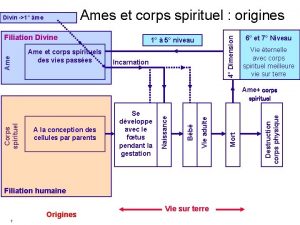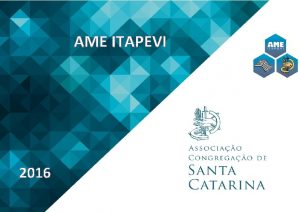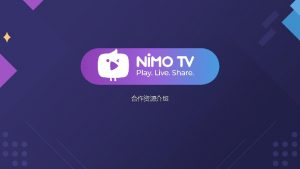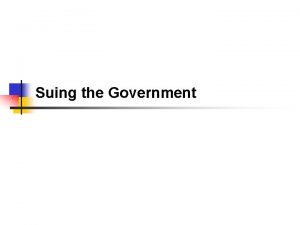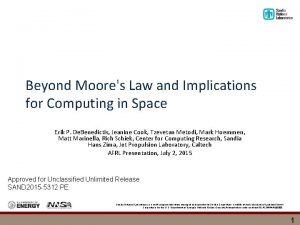AME 150 L Moores Law The USC Computing
















- Slides: 16

AME 150 L Moore’s Law The USC Computing Environment 3 - 1/14/2000 AME 150 L

Moore’s Law Moore's Law is that the pace of microchip technology change is such that the amount of data storage that a microchip can hold doubles every year or at least every 18 months. In 1965 when preparing a talk, Gordon Moore noticed that up to that time microchip capacity seemed to double each year. The pace of change having slowed down a bit over the past few years, the definition has changed (with Gordon Moore's approval) to reflect that the doubling occurs only every 18 months. 3 - 1/14/2000 AME 150 L

Moore’s Law (Consequences) • Price of equivalent technology decreases • Performance of constant cost technology increases • More computing power is available for user interface • More storage capacity increases problem sizes • And there’s moore … 3 • - 1/14/2000 AME 150 L

3 - 1/14/2000 AME 150 L

Control of Computers • Native Machine Language – Close to hardware -- depends on architecture – Can take advantage of system’s features – Often, the fastest implementation • Low level Compilers – Fortran (1950’s, Basic/COBOL (60’s), C (70’s) – Algol, Pascal, ADA, Smalltalk, C++ (OOPS) • Primitive Structured Object Oriented 3 - 1/14/2000 AME 150 L

Computing Environment & History • • 40 s-50 s-Patch Cables 50 s-60 s-Punch cards 60 s-70 s-timeshared mainframes 70 s-80 s-minicomputers & supercomputers 80 s-90 s-microcomputers & parallel systems 90 s+ … Graphic user interface (GUI) 3 - 1/14/2000 AME 150 L

Internet (1) • The Internet is a “network of networks” • USCnet follows IP (internet protocols) • Internet is organized by domains –. edu, . mil, . gov, . org, . net and. com – Domains and name-servers translate letters to a 32 bit IP address dd. dd. dd – usc. edu is 128. 125. dd 3 - 1/14/2000 AME 150 L

Internet (2) • IP is old, but not unique • IP is a “internets of peers” – No ruler or boss (all stations can be equals) – Early nets all between universities • Bitnet - organized by IBM -- mainly mainframes • DECnet - by Digital equipment • uunet -- between unix systems – ARPAnet and ERnet were early sponsors 3 - 1/14/2000 AME 150 L

Internet (3) • Internet is Scalable (others weren’t) – BITnet and DECnet required every system to have a table of every other system – uunet required you to know your neighbors, but made it hard to navigate • Networks have topology – IP is independent of topology and medium – Standards organizations, only address control 3 - 1/14/2000 AME 150 L

3 - 1/14/2000 AME 150 L

Internet Functions • • TELNET - connect to a remote computer FTP - file transfer protocol e-mail - mail transfer and news IRC - internet relay chat NTP -- netdate - synchronize clocks UDP -- user datagram protocols ICMP - Internet control message protocol 3 - 1/14/2000 AME 150 L

Internet Services at USC 3 - 1/14/2000 AME 150 L

Internet Services at USC (2) 3 - 1/14/2000 AME 150 L

World Wide Web • Of course there is a web-site • It all started at CERN (European Nuclear Research Agency) • Use of HTML (Hyper. Text Markup Language) by NCSA (National Center for Supercomputer Applications) for documentation & reports -- NCSA Mosaic 3 - 1/14/2000 AME 150 L

Role of NSF • NSF (National Science Foundation) took oversight of Internet in 1985 to foster research cooperation, and access to national Supercomputer centers • NSF sponsored Mosaic development • NCSA licenses Mosaic to Spyglass (& Microsoft) and author forms Netscape 3 - 1/14/2000 AME 150 L

USC and the Internet • ISI (Information Sciences Institute) was home to many internet support operations – John Postel • Domain Name Registrations • RFC (Request For Comments) - standards – USC Engineering in ARPAnet in 1971 • USCnet based on Internet in detail in 1987 3 - 1/14/2000 AME 150 L
 Usc ame
Usc ame Moores law graph
Moores law graph Darroch moores
Darroch moores Amy earle
Amy earle Madisonmoores nude
Madisonmoores nude Moores ssm
Moores ssm Alex moores
Alex moores Andrew moores
Andrew moores Eldridge moores cause of death
Eldridge moores cause of death Conventional computing and intelligent computing
Conventional computing and intelligent computing Newton's first law and second law and third law
Newton's first law and second law and third law Newton's first law and second law and third law
Newton's first law and second law and third law Boyles law
Boyles law Avogadro's law constants
Avogadro's law constants General confession ame church
General confession ame church Que tes vives eaux accords
Que tes vives eaux accords Dieu seul suffit que rien ne te trouble paroles
Dieu seul suffit que rien ne te trouble paroles

